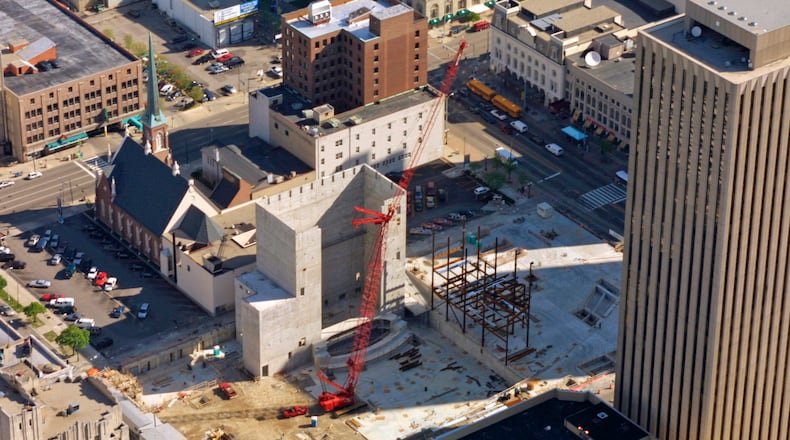The site of an institution. Ground was broken for the Schuster Center April 22, 2000. It is built on the site of the former Rike’s department store, which opened in 1912. The building was imploded in November 1999 while it was the defunct Lazarus building.
Credit: SKIP PETERSON
Credit: SKIP PETERSON
Credit: BILL REINKE
Credit: BILL REINKE
Community benefactors. The $121 million performing arts center is named in honor of Dr. Benjamin Schuster and his wife, Marian, who donated $8 million to the project. The complex of buildings includes Performance Place, an 18-floor residential and office tower.
A dream design. The building is designed by architect Cesar Pelli, who has created buildings around the world including Cincinnati’s Aronoff Center for the Arts and the Petronas Twin Towers in Kauala Lumpur, Malaysia, among the tallest buildings in the world.
Space for the community. The 13,000-square-foot glass Wintergarden was designed to be the "public room" of the structure, according to a 2003 interview with the architect. When it first opened, palm trees, 35 to 40 feet tall, were shipped in and planted creating a grove inside the atrium. "You won't feel alone" in a room containing living things, said Pelli.
Credit: Skip Peterson
Credit: Skip Peterson
Birds of a feather. During construction, a trio of sparrows made their home inside the Wintergarden, flitting around and eating construction worker lunches. A community naming contest began and suggestions flew in including, Schu-Schu (for Schuster), Rickey (for Rikes) and Deux-Main (for Second and Main Streets). Other suggestions were Spirit, Freedom and Peace and the Three Tenors.
Credit: Chris Stewart
Credit: Chris Stewart
Designed to inspire. Inside the state-of-the art Mead Theater, all eyes are drawn up into elliptical telescoping conical forms. The beautiful curves are there to provide "the drama before the drama," said Pelli. At the top the domed black ceiling is decked with 780 fiber-optic lights of various sizes, arranged to match the night sky over Dayton on the eve of the Wright brothers' first flight.
A tribute to the first flight. The light display, referred to as the “Starfield,” is the exact width of the Wright Flyer’s wingspan, and the length from the ground floor of the performing arts center to the tip of the “Starfield” is the exact distance as the first successful flight made by the Wright brothers, according to the Dayton Performing Arts Alliance website.
Credit: Shiloh Crawford III
Credit: Shiloh Crawford III
Standing room only. It is estimated that more than 70,000 people attended the community open house for the 388,000-square-foot performing arts center on March 2, 2003. Crowds braved wind and snow and stood in a line wrapping around the building for almost an hour to tour the new community landmark.
About the Author





